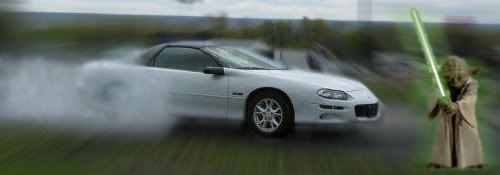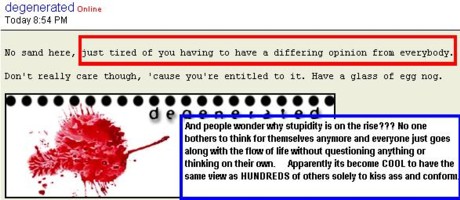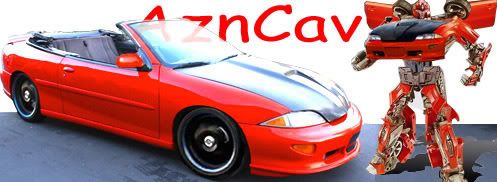Intake temperature comparison test:
Quote:
CAI vs. Pop Charger vs. OSCAI: Intake Temperature Test Results
I perused quite a few SAE articles regarding intake temperatures and their effect on different engine applications and found an interesting standard: By using the SAE correction factor "B" for temperature's effect on horsepower, we see that the correction factor for temperature is approximately 1% per ten degrees. That is, you get a 1% increase in horsepower for each 10 degrees you lower the temperature of the incoming air into your filter.
I am certain that many of you have personally felt the difference, on a cool, perhaps damp
(there is another correction for that) morning, when your car seemed to have more power than usual, and that those of you who have been lucky to participate in track days have posted lap times in the cool of the morning you could not equal on the warmer afternoon sessions.
This finding prompted me to swing by the local Radio Shack and purchase a digital thermometer with the sensor attached to its 10-foot wire. I attached it to my door.
http://images.cardomain.com/install...172_17_full.jpg
I then routed the wire connected to the thermometer’s display out the window, under the hood and inside the cone filter to get the exact temperature of the air entering the throttle body.
http://images.cardomain.com/install...172_19_full.jpg
Here is what I tested:
1) Intake Temperature at IDLE (8 minutes) with Pop Charger
2) Intake Temperature at IDLE (8 minutes) with CAI (I placed sensor in drainage hole in fender where the CAI would reside)
3) Intake Temperature with Pop Charger
4) Intake Temperature with CAI (I placed sensor in drainage hole in fender where the CAI would reside)
5) Intake Temperature with OSCAI (A 2” tube connected to a scoop under the car bringing cold-air to the filter. SEE
http://images.cardomain.com/install...172_11_full.jpg
Here are the results:
Outside Temperature: 34 degrees F
Test length: 2 Miles/Run
1) Intake Temperature at IDLE with Pop Charger: 95.8F and increasing
2) Intake Temperature at IDLE (8 minutes) with CAI (Sensor in hole in wheel well): 51.2 Steady
3) Intake Temperature with Pop Charger
Temp @ 40 mph: 47.6F
Temp @ 70 mph: 44.2F
Notes: The temperatures were volatile and increased when accelerated hard or came to a brief stop. Temperatures would not reach their low until the end of the run. When stopped for more than 2 minutes, the temperature would rise quickly to between 60-65 degrees.
4) Intake Temperature with CAI
Temp @ 40 mph: 45.1F
Temp @ 70 mph: 39.8F
Notes: Idle temps were already low, so low temperatures were achieved quickly. The temperature did not vary and stayed relatively constant when accelerating hard or stopping. Extended periods of idle would bring the temperature up, but not significantly. I suspect using the fender well as a heat shield aided in the temperature consistency.
5)Intake Temperature with OSCAI
Temp @ 40 mph: 45.0F
Temp @ 70 mph: 40.9F
Notes: The rate of change for the temperature was dependent on the speed I was going. The temperature increased when accelerating hard or coming to a stop, but quickly returned to it’s low under steady driving. Again, as the basic pop charger set-up did, momentary stops for 2 + minutes would send the temperature up to 60-65 degrees.
Conclusion/Serendipity
I was surprised that the Pop Charger by itself, without the CAI or OSCAI set-up was able to produce almost same temperature reading as the other two at speed. I guess, from what I gathered, the CAI benefits the most by creating a ceiling for temperature not to exceed (in this case 50 degrees) whereas the other two allow the intake temps to climb at the engines heated will. This 40 degree difference can be a factor in ¼ mile times where the car must idle for extended periods of time before launching. But as the outside temperatures increase, so will the air in the wheel well, thus making the differences slight. Additionally, I am not certain what adverse affects the longer tube combined with a bend may have on the intake airflow. Perhaps the tube may heat up thus warming the cooler air.
In the end, when comparing the extremes of winter and summer weather, say 10F vs. 100F (engine temps) and using the 10degree/1% power gain correction factor equation, in the Maxima’s case:
100-10 = 90 * .10 = 9% power increase for a 190 hp car which is somewhere around a 17 horsepower difference between the extreme summer and extreme winter case, then I guess cold air should be taken seriously. But when the difference between the ways of obtaining the cold air and inducing it into your engine yield almost the same results at speed, then what should you do? Who knows…
But maybe you could get a head start by using my write up! Enjoy and feel free to comment or add variables or conclusions that I have left out.
-Raceen
str8ridin
Gas mileage test:
Quote:
MetroMPG01-12-2006, 03:04 PM
the summary is:
CAI (performed 5 bi-directional runs)
54.3 F avg air intake temp
79.12 km/gal (US) avg consumption
WAI (performed 4 bi-directional runs)
106.7 F avg air intake temp
79.31 km/gal (US) avg consumption
it's always disappointing to put this much work into something and not see any significant results.
in case you're wondering, that's a .2% (point two percent) difference of WAI over CAI. i haven't calculated margin of error yet, but i suspect it's within it, which would make the difference statistically insignificant.
details and methodology to come later on...
Hot air from asphalt is going to be nowhere near the temp of the engine bay. Once the car is moving, the air hitting the CAI is getting ambient temperature.
Also, a fallacy I keep hearing is that if the tube is hot, the intake air is hot. The air is moving very fast, and needs to be idle to warm up, which is
not happening. Try taking a pipe and put it on a heat source of 150 degrees temp, now pour water through it that is the same temp as the outside, say 80 degrees. Let it pour quickly through at a steep angle into a jar. Stick a thermometer in the water, I bet you it will be 80 degrees or within 1 degree of it.
Some would say the WAI "should" have more velocity, but... think about this, velocity is created by the intake vaccuum. If the bends of the CAI slow this in any way, then the WAI "would" have one advantage.
At WOT, the CAI has all the air a 4 banger is going to ask for.
Yes, less bends "can" make for better flow, but
it has to hit a point where it is a hinderance.
Has it hit that point with a CAI?
I seriously doubt it on a 4 banger.
The intake tube is
huge, and albeit some bends, still wont be making the throttle body have any 'less' air coming in even at WOT.
Use the same logic with a beer bong.
The person can only fit X amount of beer into the mouth.
The tube on both are huge, more than necessary.
One has a couple extra bends, the end result will be a lot of beer being wasted and falling to the ground with or without bends.
The reason is, by design, a person's mouth will only fit so much beer in, and both designs deliver MORE than a person can handle.
In other words, the volume required at any possible point is met by both designs.
I have seen people with their beer bongs being held bent and straight down and I never see anyone without a wet shirt and puddles on the ground afterwards.
This is just to attempt to put it in a perspective that some may understand.
Volume is just one factor though.
The fact that a WAI can have an increased temperature at the intake of 20 degrees more makes me wonder why people believe the WAI is better.
Gas mileage is a hair less with a WAI too.
.2% is a very small difference though.
I always get better mileage when I clean my filter, and also notice a little more pep.
If the WAI is getting less MPG, then I would have to venture to say it is going in the opposite direction.
In fact I have seen people record losses in HP with WAIs.
Maybe on the J-body something magical happens and WAIs are better...lol
2003 Sunfire with 2 1/4 inch turbo muffler, 2 1/4 piping, 2 1/2 inch resonator, a 2 1/4 inch catalytic converter, 2 1/2 inch down-pipe, a 4:2:1 RK Sports 'clone' header, E-bay strut brace, ground wire kit and an AEM true cold air intake NOPI edition.












